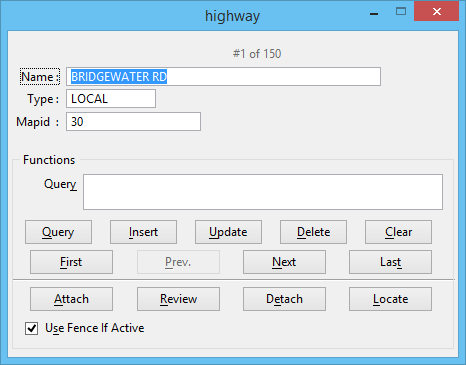| Query result section |
(not labeled) The query result for the fields selected in the <TABLENAME> dialog appear in the query result section (the top section) of a database dialog form. Also displayed is identification of which of the query result records is being displayed, if Count Row Label is on in the Standard Form Items dialog. For example, "#3 of 16" indicates that the query resulted in 16 records and the third record is displayed in the query result section.
|
| Query |
Executes queries, by typing an SQL statement into the Query text box or by entering values in the form dialog text fields, and then clicking Query. |
| Insert |
Adds a new database record to the end of the table. The behavior of this button chances based on the following three scenarios:
- If the MSLINK field is on the form and left Blank when the Insert button is pressed, the following message is returned: The field "yourtablename.MSLINK" cannot contain a Null value because the Required property for this field is set to True. Enter a value in this field.
- If the MSLINK field is on the form and is populated when the Insert button is pressed, the form attempts to use that MSLINK value when inserting the record.
- If the MSLINK field is not on the form, and when operating in "NEW" linkage mode, the software populates the MSLINK value for the user when the INSERT operation occurs. In other words, in order to cause the form to populate the MSLINK automatically, omit the MSLINK field when creating the form.
|
| Update |
Updates field values of the currently displayed row. Click a field value, type in the new value and click Update. |
| Delete |
Deletes the currently displayed row. |
| Clear |
Clears the values in the currently displayed row. The values are not deleted from the database, however. |
| First |
Navigates to the first row of the query results. |
| Prev |
Navigates to the previous row of the query results. |
| Next |
Navigates to the next higher of the query results. |
| Last |
Navigates to the last row (highest numbered) of the query results. |
| Attach |
Used to attach the current database record, as displayed in the list box, to a graphics element or to all elements within a fence. |
| Review |
Displays a database record linked with an element that you identify on the screen, if you select an element which is of the same type as the form dialog. For example, if you have a MONUMENT form dialog open, you must identify a monument on you screen in order to retrieve the monument's database record. Note: The Review Attributes tool (key in: REVIEW) will return the database record regardless of which linked element is identified. If you click Review in a VSQL form dialog however, the Review command will return database records only if you identify an element which has a database linkage to the table from which the form dialog was built. The name at the top of the form dialog identifies the table.
|
| Detach |
Used to detach the current database record. |
| Locate |
Used to locate a an element or area linked to the currently displayed database record. It centers and highlights the element in the selected view. For Locate to work, your query must include MSLINK. If the element is not present in the currently opened design file, an informational dialog opens with the message "No element linked in the current row". The Locate command looks for the record's element in the current design file, and displays the record if it is found.
|
| Use Fence If Active |
If on, the fence is used for processing. This control appears if the Use Fence Toggle is turned on in the Standard Form Items dialog. There are three possibilities:
- Use Fence If Active is not present (on a form dialog)–clicking Review works in conjunction with a fence, if one is placed.
- Use Fence If Active is present and on–Review works in conjunction with fence if one is placed.
- Use Fence If Active is present and off–Review ignores any fence that is placed.
|

